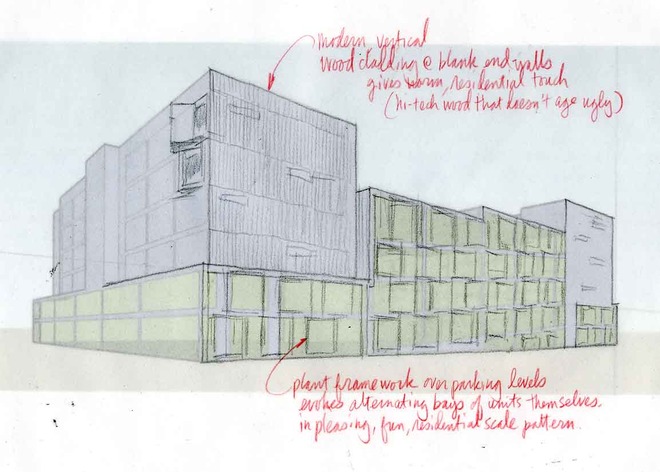There is somethng visually powerful about the look of old school blueprints. To many of us over 40, white lines on a deep blue background say "architecture" and design like nothing else.
Architectural Presentation Techniques: The Art of the Digital Sketch
In yesterday's post about loose architectural sketches, we talked about traditional pencil and pen-and-ink sketches. Today we'll talk about what I call a loose digital sketch. The loose digital sketch begins with a loose manual sketch composing the view and identifyling the important elements in the proposed design.
But then the loose digital sketch takes a turn to photoshop.

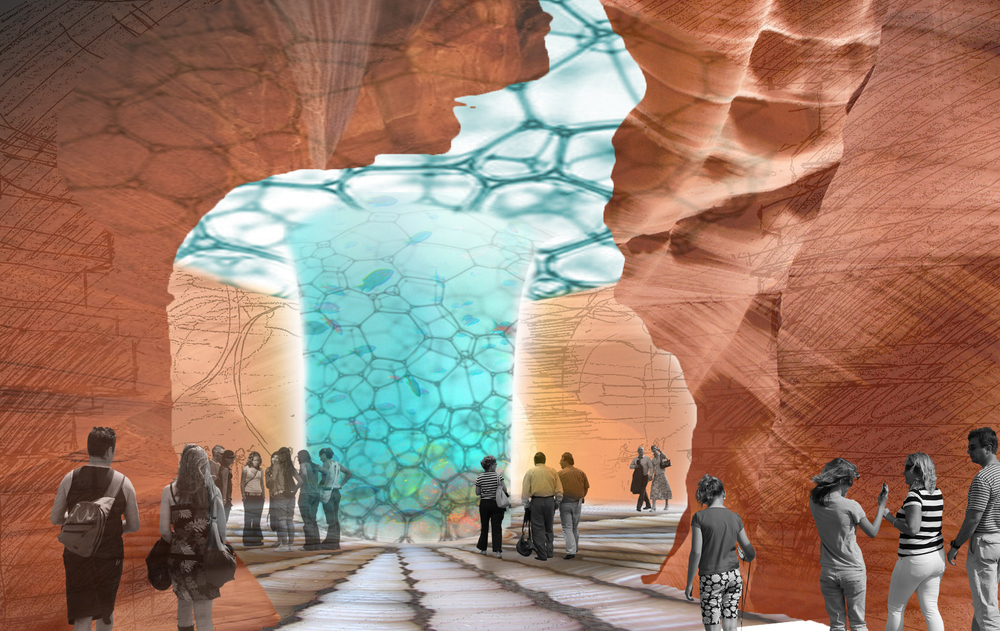
Working closely with the designer, the architectural renderer...
Architectural Rendering Technique: The Art Of The Loose Sketch
Even in this digital design age, there is a place for the loose architectural rendering. It is fast where other architectural rendering techniques are slow. It is non-commital, where digital rendering has to be precise in order to look good. It's also not a bad metaphor for life. What do I mean by that?
 Loose architectural renderings and sketches are still one of the most important architectural rendering techniques. In this example, the author uses felt tip pen to work directly on top of the soft pencil sketch used to visualize the space and develop the design before the architect's eyes. This insures that the sketch stays loose and that one's attitude toward the rendering does not become too precious.
Loose architectural renderings and sketches are still one of the most important architectural rendering techniques. In this example, the author uses felt tip pen to work directly on top of the soft pencil sketch used to visualize the space and develop the design before the architect's eyes. This insures that the sketch stays loose and that one's attitude toward the rendering does not become too precious.
I mean, how many times in life is 75% or even 85% of the idea...
Pencil Sketching is the New Computer Aided Design
As digital modeling and architectural digital rendering continue to chnage our industry for the better, the arts of architectural rendering and architectural sketching in watercolor, pencil, and pen-and-ink become huge asstes in the constant battle to stand out among competitors all using the same digital tools.
 Architectural sketching and storyboarding in watercolor
Architectural sketching and storyboarding in watercolor
They engage clients' emotions, connecting with that deep thing that persists in all of us--that ability to...
Architectural Sketching and Rendering For The Digital Rendering Age
 Above: This architectural sketch (or what some might call an architectural rendering) in pencil shows the architect's design concept for an underground book storage addition to the Princeton University library. Visualizing the design concept in quick pencil sketches not only engaged the client in an attention-grabbing ad humanistic way, it also served as a kind of art direction to help guide the third party architectural digital renderers.
Above: This architectural sketch (or what some might call an architectural rendering) in pencil shows the architect's design concept for an underground book storage addition to the Princeton University library. Visualizing the design concept in quick pencil sketches not only engaged the client in an attention-grabbing ad humanistic way, it also served as a kind of art direction to help guide the third party architectural digital renderers.Ahh the Smell of Pen and Ink Architectural Rendering in the Morning
Pen, ink and tracing paper remains one of the effective forms of architectural rendering ever devised, but what if we combined it with photoshop and a digital aesthetic?

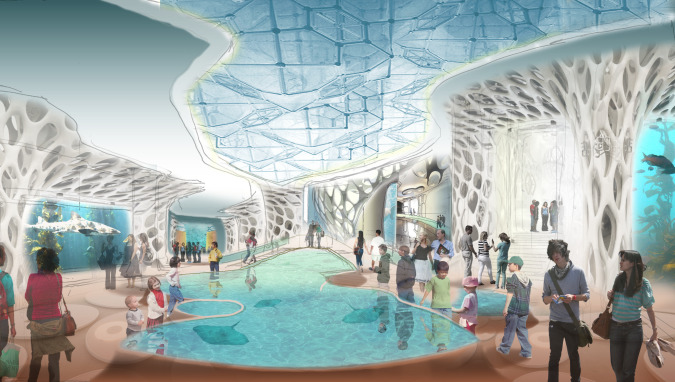
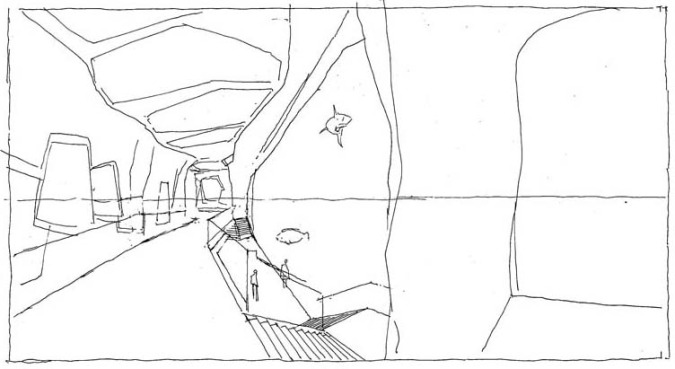
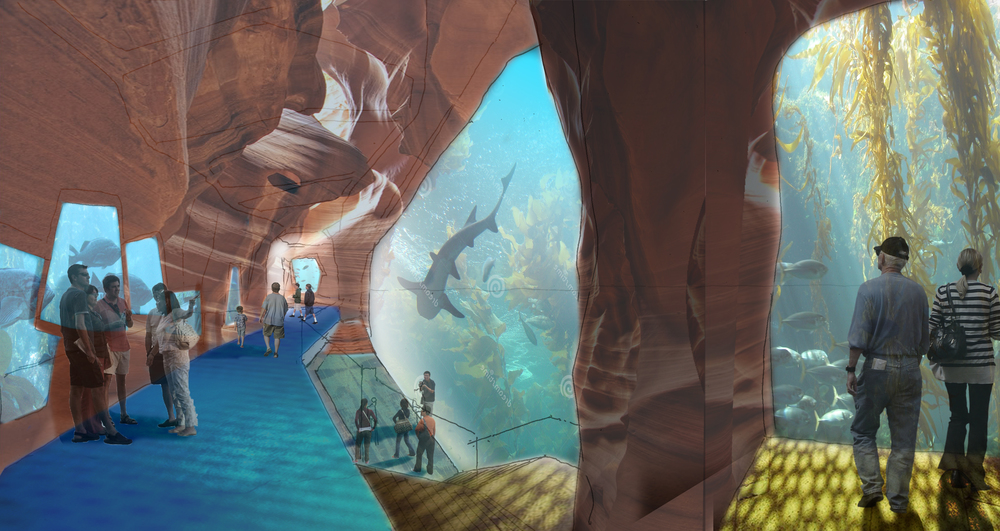
This architectural rendering project was a lot of fun, done right in the architect's office with close collaboration between architect and architectural illustrator. I would love to know what you think? Please leave coments below.
(The author is a registered architect and architectural illustrator with years of experience helping architects and interior designers develop and present their ideas in dramatic and cost-effective ways. From concept design to final presentation, we work in your office or from our NYC studio. 413-250-8800.)
Drawing and Watercoloring For Architects (A Proposal For Grads New and Not New Who Lament The Loss Of These Skills)
At every office I work with, it seems that fewer and fewer new architectural grads have an opportunity to use their (often VERY impressive) traditional drawing and watercoloring talents. There's nothing inherently bad about the fact that few of us need any longer to draw in our day jobs, or that unprecedented computer possibilities have displaced the need for these skills, but still...I wonder if some future Stanford brain scientist might discover that the profession-wide loss of these skills turns out to have been the loss of something deeper?

Like the ability to rotate imaginary objects and spaces in our heads, or...
A Year-End Thanks To You, Reader, And Your Picks For This Blog's Best Posts of 2015
It’s day three (or is it four? I’ve lost count) of the approaching 2015 year-end holiday season. You’re getting sick of reading the same old online sites: Huffpo, NYT, Fox News, what’s the difference? Why not take a break and read what you voted for as this blog's Best of 2015? And don't forget to join the discussion by leaving your comments!
With humble gratitude for your attention, I give you: the best of the 3-D Visualization Blog, 2013
The Best Ways The Digital Revolution Changed My Life-Part One
If you went to architecture or environmental design school back in the day (when you had to use punch cards to enter data into a room-sized computer), you have witnessed the great shift from analog to digital in the design industry. You’re also old enough to have begun taking for granted the many ways the digital revolution changed our professional lives.
As 2013 draws to a close, seems like a reasonable time to share a personal list of “best ways the digital revolution changed my professional life.” Since I tend not to use CAD--arguably the tool that has had the most influence--my list will be different from yours, but please add your own list in the comments section below. (And no, you don’t have to be an architect to play along.)
 Jimmy Stewart, from that famous movie
Jimmy Stewart, from that famous movie
So here we go: my list of the best ways the digital revolution has changed my life:
-
The internet. Thank you, Tim Berners Lee. Thank you, DARPA (although you also brought us the NSA. Why does every sword have to be double-edged?). Let’s just agree that the internet is the background noise of the new universe described below.
-
Email. The reigning game changer. Email could have retired after killing the fax machine (bonus points if you knew “fax” was short for facsimile) but it didn’t. It just kept getting better...
Pitch Your Schematic Design Ideas With Digital Sketches, NOT Digital Or Traditional Architectural Renderings
Presenting schematic architectural and interior design ideas to your client in the digital age can be challenging. The problem? The photo-literalism of digital images can, if presented too early, elicit an equally literal response in your client and put the organic “Concept-to-DD-to-CD” design process at risk.

Like all technological advances, digital architectural rendering presents us with a double edged sword. On the one hand, digital software gives designers the unprecedented power to present schematic design ideas as photorealistic fait accompli. On the other hand
Use Digital Architectural Sketching To Streamline Client Approvals
It's one week before your next big design meeting. You have multiple ideas to present, but your goal is to secure your client's approval of a single direction so you can complete this phase, bill for it and move your team on to the next.

Back in the day, architects solved this problem by presenting loose architectural sketches (with maybe a little color thrown on them), blown up several feet wide so as to wow the client with vagueness...but times have changed and clients have changed with them.

Modern clients have grown up in a world of photo-realistic digital images.Their parents understood that hand drawn sketches and diagrams were a part of the design development process, but this generation has
Architectural Rendering Techniques: Painting an Architectural Elevation in Watercolor
The world of architectural rendering is changing...or is it? Even in this digital age, architectural renderings need to communicate a specific design while delighting the senses. Whether you use digital architectural rendering techniques or traditional architectural rendering techniques to do that, I hope you enjoy this post documenting the techniques I used creating a traditional architectural rendering in watercolor made for the Yale School of Music (as a gift to the donor giving the funds for the addition at the left of the original building in the photo below).
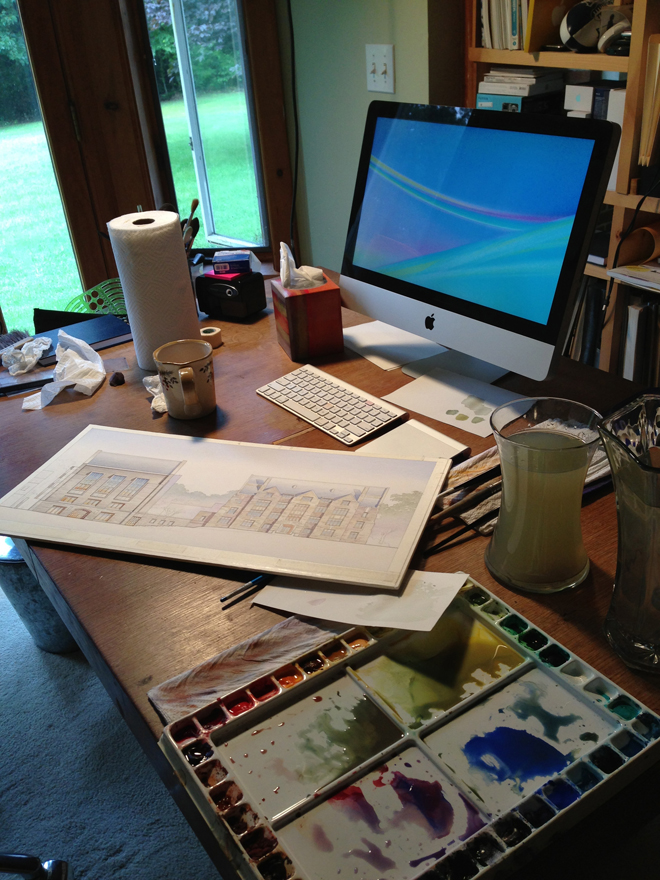 This is my current set up: computer for email, image research and Pandora; watercolor palette and old school drawing implements, bookshelves and sideyard beyond
This is my current set up: computer for email, image research and Pandora; watercolor palette and old school drawing implements, bookshelves and sideyard beyond
With your permission, I'll keep words to a minimum and let the images speak for themselves.
Traditional Architectural Rendering Plus Digital Architectural Rendering Equals Hybrid Architectural Rendering
Architects have had to be resourceful since the bankers brought the global economy to its knees in 2008. I mean, we taxpayers with jobs couldn't let the bankers starve, could we? Still, after we shared our own after-tax income to save these valuable executives and restore their bonuses, architects (and a few other professions) had the problem of finding work to replace that income. (OK, I'm being silly here. Nothing said the rest of us had to maintain our lifestyles or send our kids to college.) That's when we began re-inventing ourselves: finding new clients, downsizing our firms, exploring more efficient ways to deliver services and get the ball rolling again.
 My thanks to my friend Chad Rush for his help in coloring this puppy
My thanks to my friend Chad Rush for his help in coloring this puppy
One of the ways that architectural renderers have reinvented themselves is to blend the world of traditional architectural rendering with digital architectural rendering, resulting in the so-called hybrid architectural rendering. Some argue that the hybrid architectural rendering combines the best of both into a compelling new form that connects the work with the emotions of the client and helps architects differentiate themselves from the pack. Others just think it looks cool and gives the client more options to quickly explore a mood or time of day.
 Here is the original pencil tone drawing of a proposed nightclub terrace in Las Vegas. (Architect's name withheld by request)
Here is the original pencil tone drawing of a proposed nightclub terrace in Las Vegas. (Architect's name withheld by request)
Whatever your opinion, I hope you will...
Hybrid Architectural Renderings Mix Traditional Architectural Renderings Techniques With Photoshop
We've talked quite a bit about hybrid architectural renderings in this blog. A hybrid architectural rendering is any rendering that mixes traditional and digital techniques so as to leverage the best characteristics of both.

Traditional architectural rendering, as the argument goes, communicates at some deep level in the human brain, connecting people--even against their will, Don Draper might say--with emotions still stirred by handmade artifacts, as in a handmade drawing or painting.
Digital architectural rendering techniques, on the other hand, brings advantages no human artifact can compete with: the illusion of photo-realism; the advantages of infinite visual adjustment in very little time, and my favorite:
New Trends In Traditional and Digital Architectural Rendering
If you are an architect, landscape architect, interior designer or traditional or digital architectural renderer, the world changed in 2008: work dried up, firms cut their payrolls, and up to 50% of us lost our jobs and had to reinvent ourselves.
 A hybrid architectural rendering combining digital and traditional techniques to project the accessibility of a proposed children's museum.
A hybrid architectural rendering combining digital and traditional techniques to project the accessibility of a proposed children's museum.
 Hybrid architectural rendering of seasonal decoration scheme for world's most famous fish marketThose who survived were sobered by the central lesson of the new economic order:
Hybrid architectural rendering of seasonal decoration scheme for world's most famous fish marketThose who survived were sobered by the central lesson of the new economic order:
What Digital Services and Startups Are Architects and Designers Using?
Welcome email newsletter subscribers. Please take a moment to list in the comments section below the digital services and startups you are using (e.g. Pinterest? Uber? Tumblr?) to market your services and make your designing life easier. We'll report them all in a future newsletter. Thanks!

What Do Architects And Designers Listen To All Day?
Welcome email newsletter subscribers. Please take a moment to share in the comments section below the radio stations, music services and podcasts you listen to throughout the day. We'll share them all in a future newsletter. Thanks!
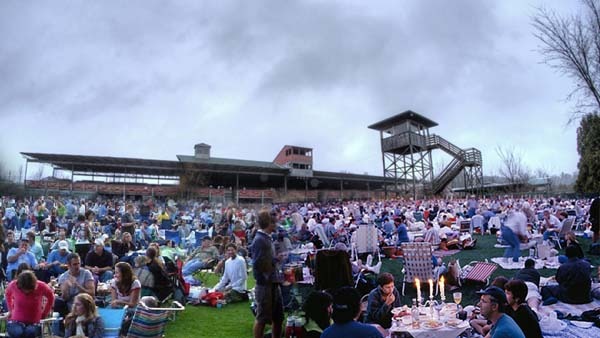
Hacking Gmail to Keep Track of Your Favorite Internet Discoveries
One of the reasons I love gmail is because of the many ways you can casually hack it. For example, when I come across a post or an idea on the internet that I want to keep track of, I email it to myself with the word "Keeper" (as in fishing) in the title. Then I set up a filter that keeps everything with the word "Keeper" in the title in a folder named Keeper. That way all I have to do is click on the Keeper folder (in the left hand list of folders in my gmail) and boom: everything is right there.
OK, so you already knew that, great. But did you put the following amazing link in your Keeper folder? It's a kind of storyboard that a favorite illustrator of mine, Christoph Nieman, created after hearing an interview between Terry Gross and Maurice Sendak. I'm sure he had help at the NYT turning it into this sweet little video, but please enjoy:
App Design
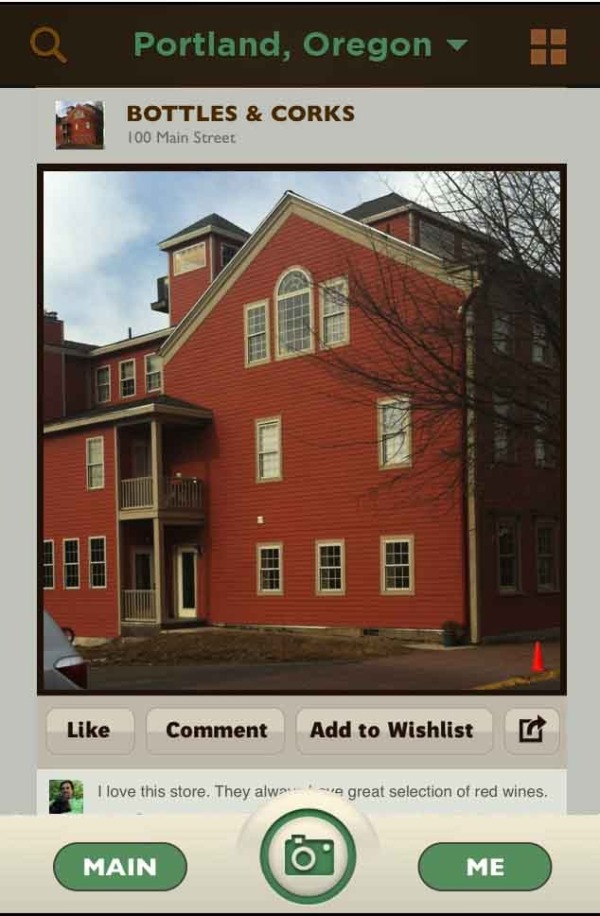
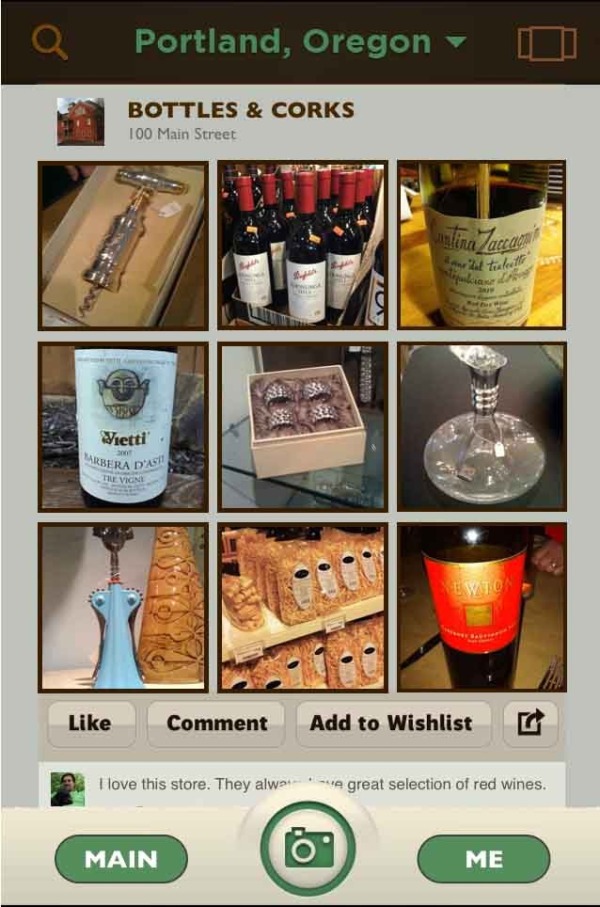
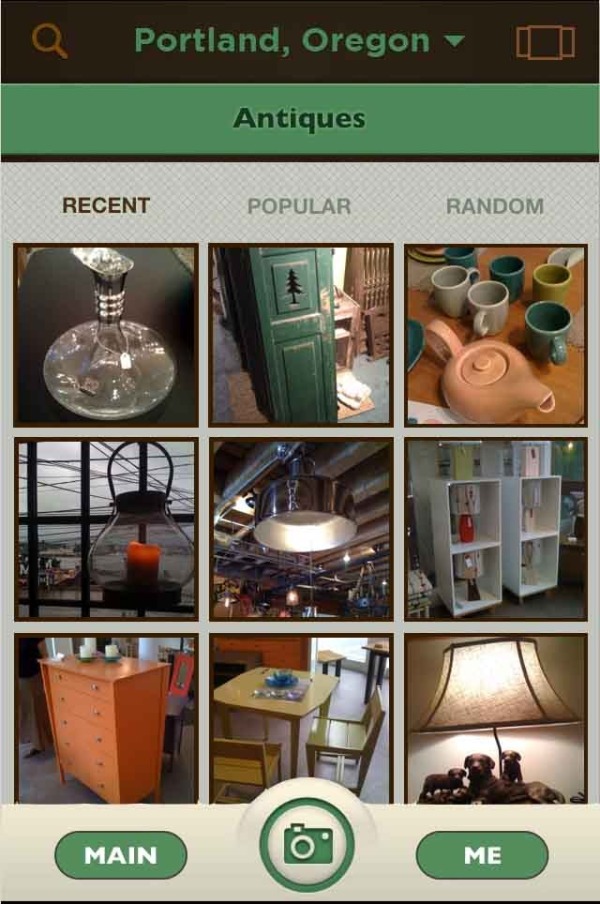

Fast, Low-Cost Architectural Sketches Help Realtors and Prospective Buyers Study Design Options Before Buying
As an architect who specializes in early-stage concept design, architectural sketching and rapid visualization, I get to serve as one-stop shop for realtors, developers and prospective homeowners wanting to study their options before committing to buying an important property, or before engaging a "high profile" architect who, given the pressures of running a large practice, might just assign the exercise to a couple of talented in-house designers anyway.
In the collaboration posted here, I worked with a Boston developer to sketch (in a fraction of the time required by a larger firm) the look and feel of a 120-unit, future-looking condo project in a prosperous Boston suburb.
 Early study based on SketchUp massing study: the Idea of pre-fab, stackable units enters inWe used a combination of traditional and digital architectural rendering techniques to explore her options, culminating in the simple black-and-white digital renderings at the end. Unfortunately, the banking meltdown of 2008 nipped the project in the bud, but...
Early study based on SketchUp massing study: the Idea of pre-fab, stackable units enters inWe used a combination of traditional and digital architectural rendering techniques to explore her options, culminating in the simple black-and-white digital renderings at the end. Unfortunately, the banking meltdown of 2008 nipped the project in the bud, but...






